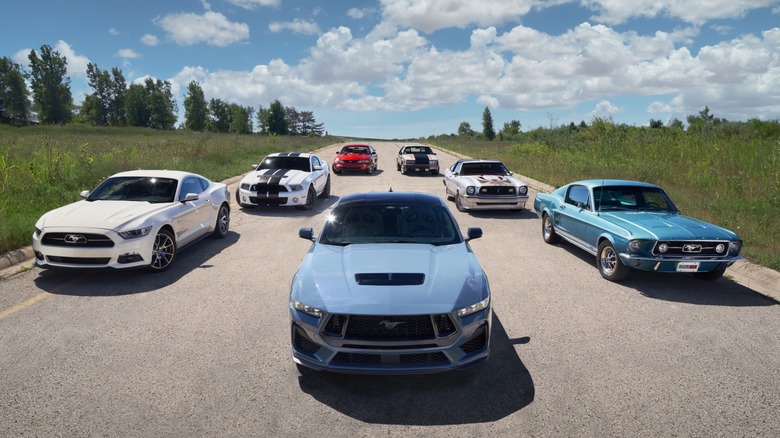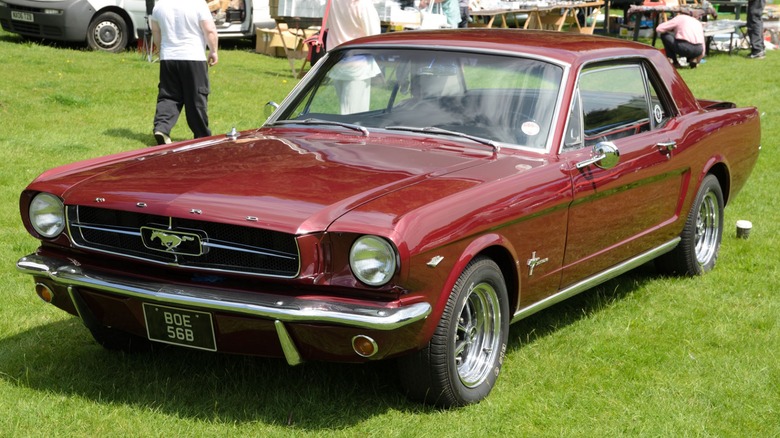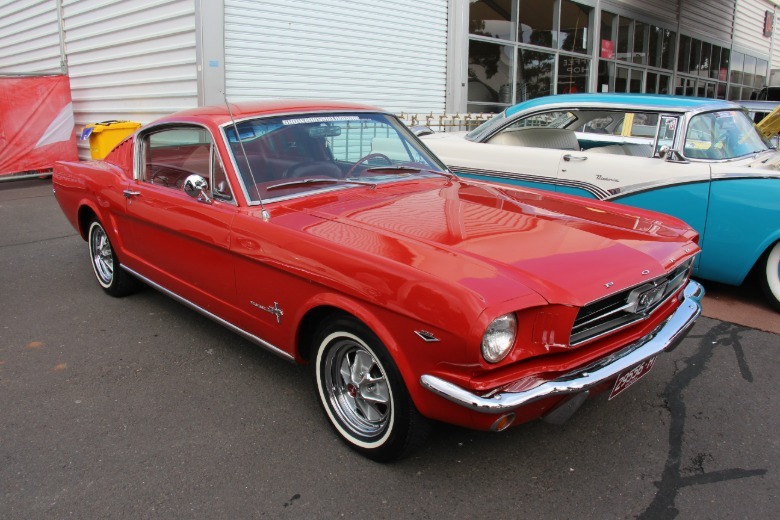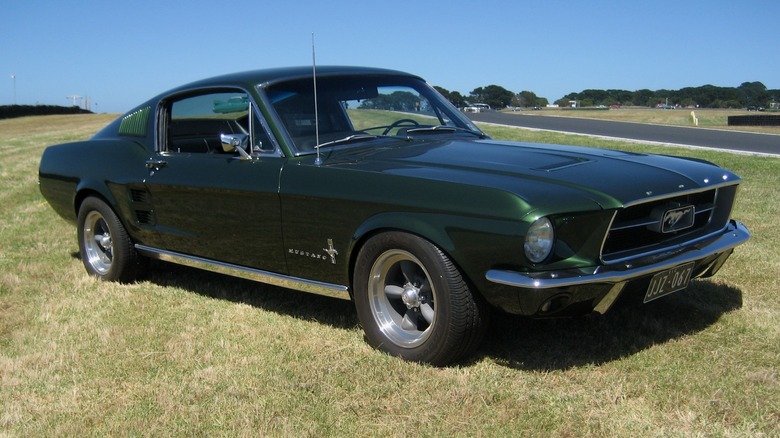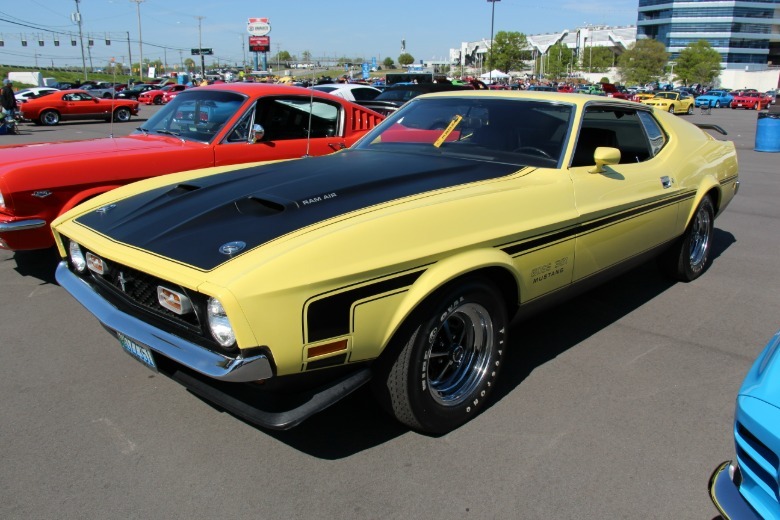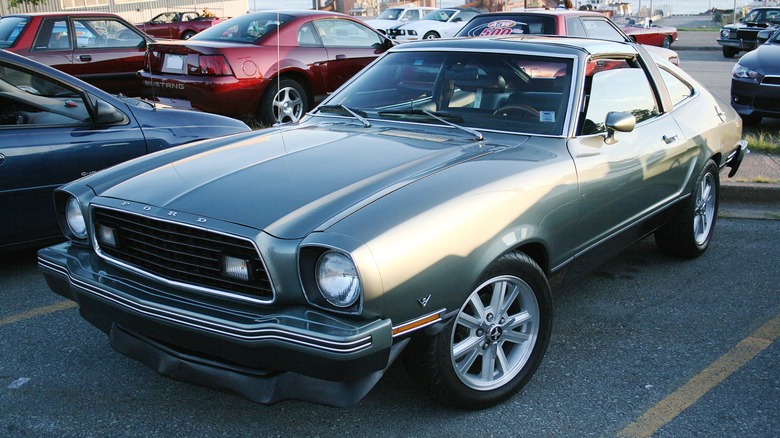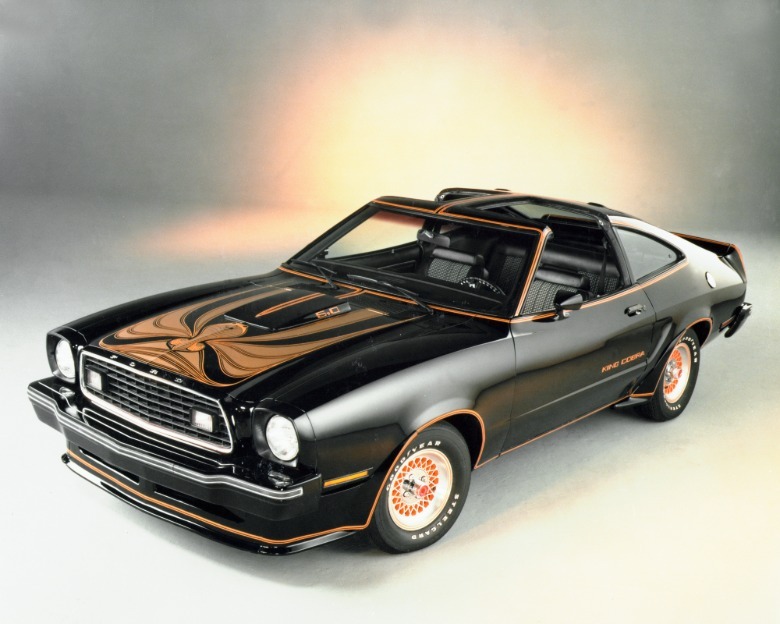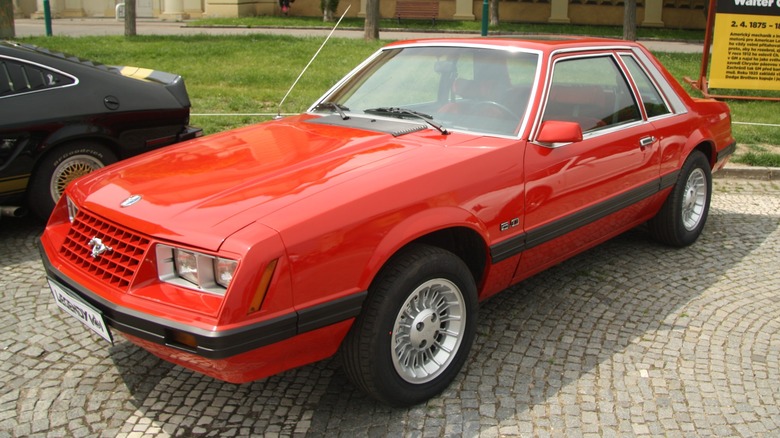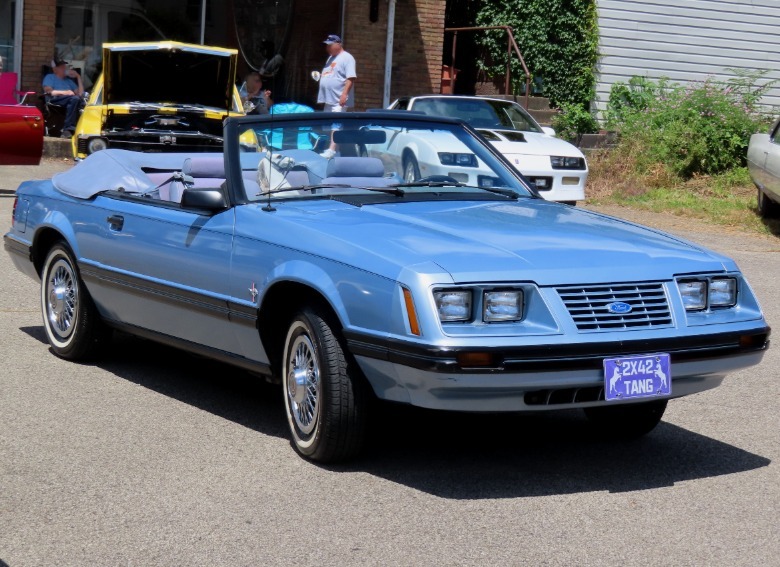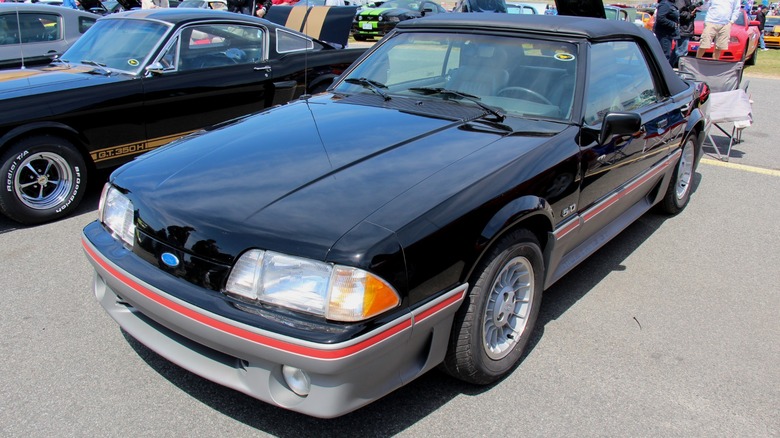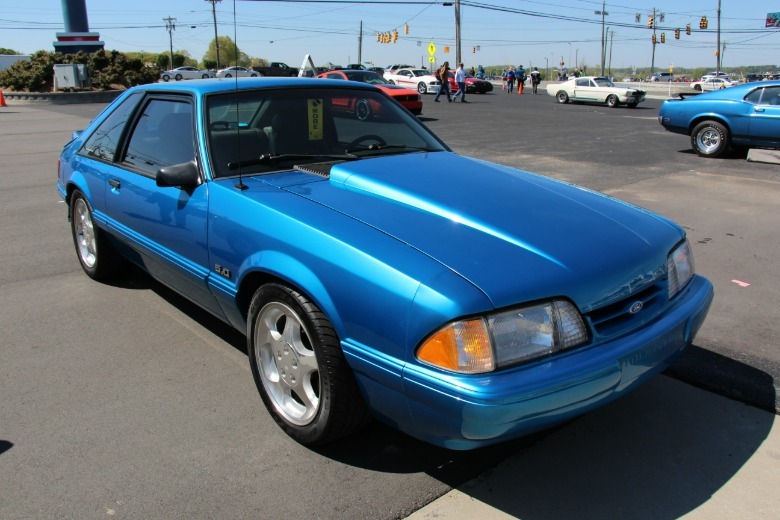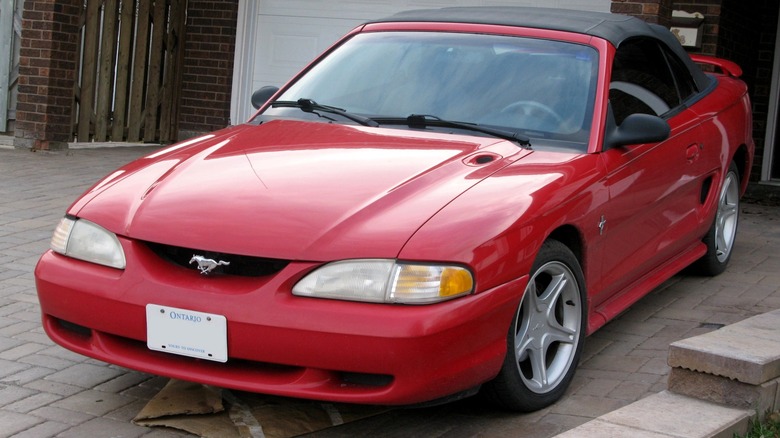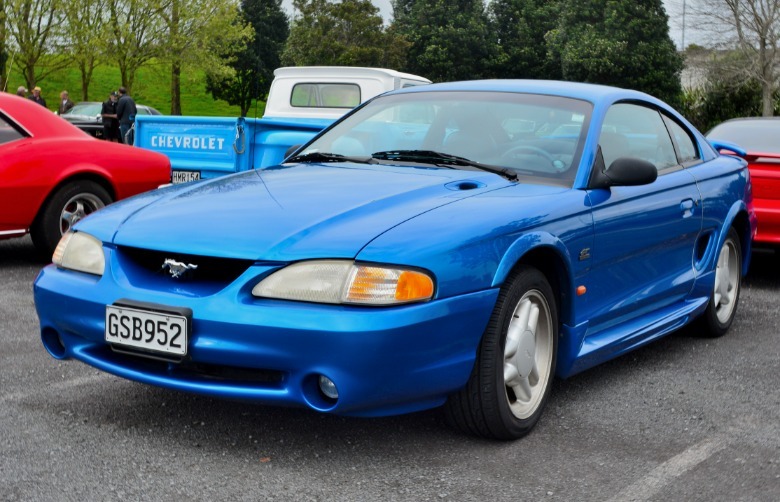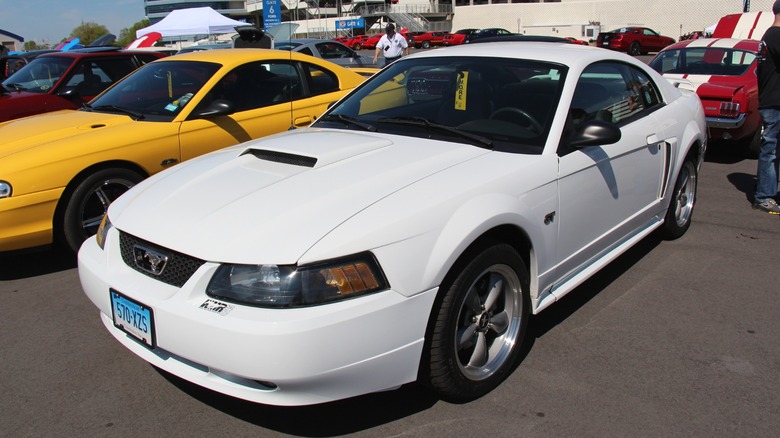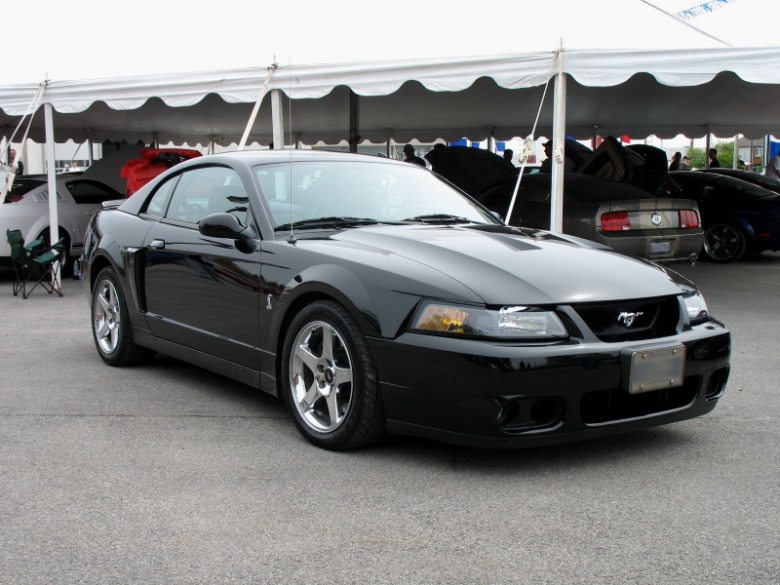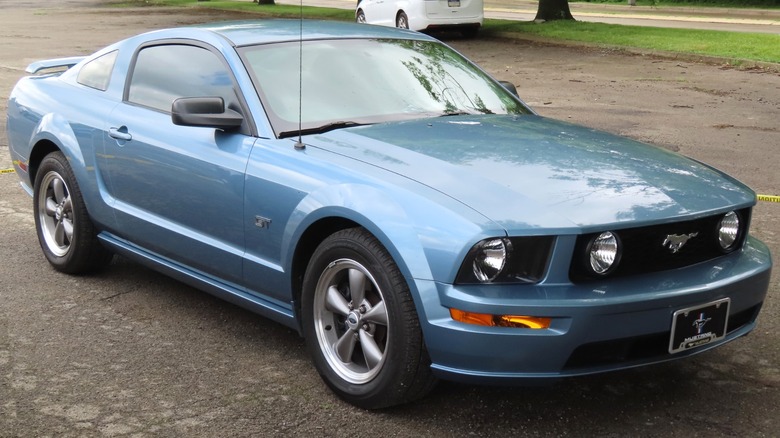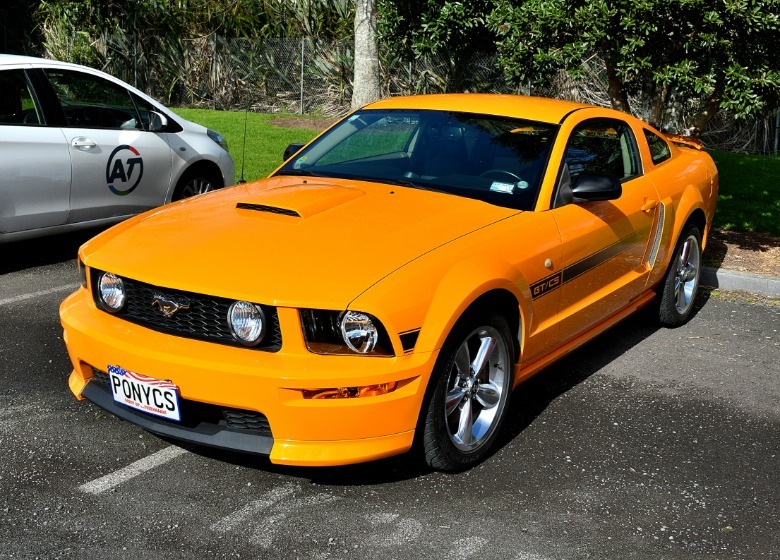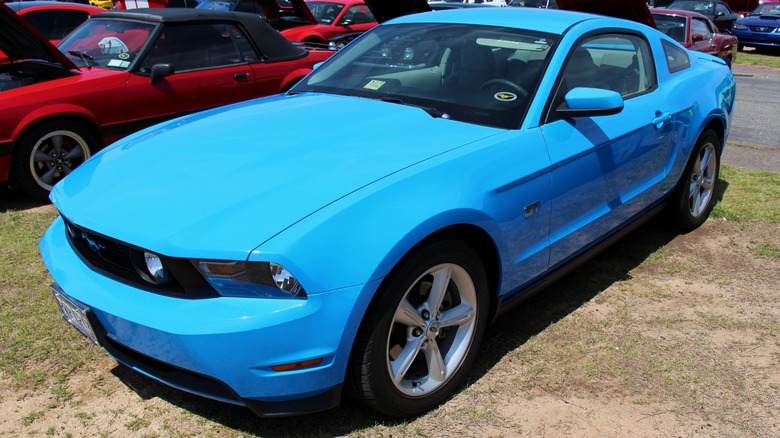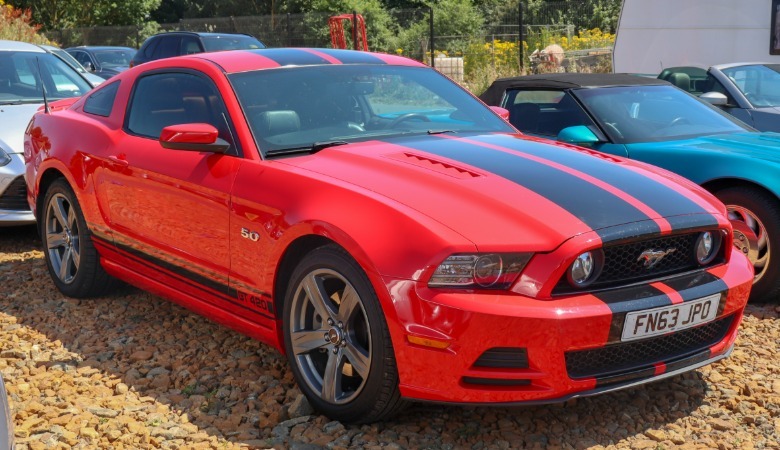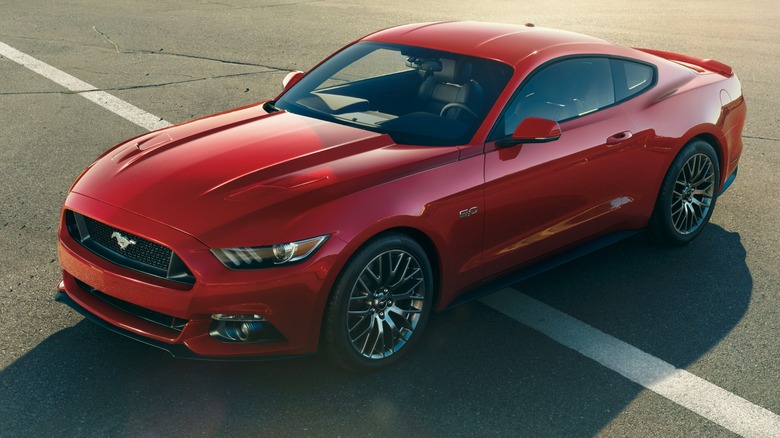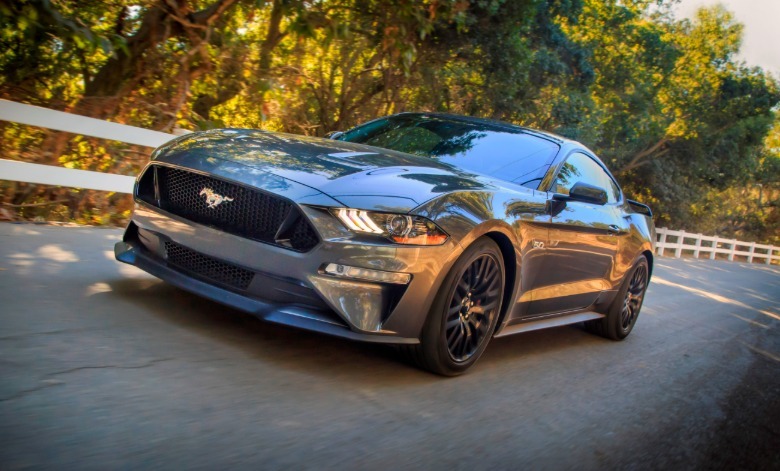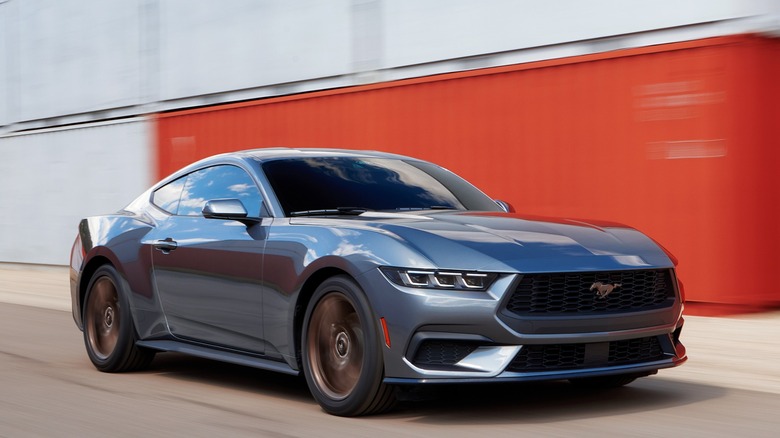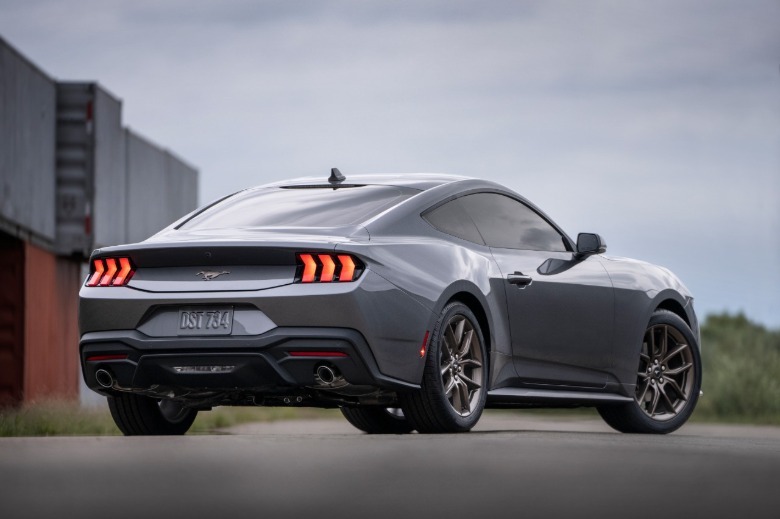Ford Mustang Body Styles By Year: A Visual History
When it comes to American muscle cars, few names are quite as legendary as the Ford Mustang. The brainchild of Ford vice-president Lee Iacocca, the Mustang was an instant hit when it debuted in 1964, with dealers moving 22,000 units on the first day alone. The momentum carried on, too, with total sales of more than 418,000 units during the car's first full year.
The Mustang wasn't necessarily the first-ever pony car, but Ford's offering arguably helped define the style, establishing a template for powerful and compact sports cars that would carry on over the next few decades. The result was a long lineage of very cool American pony cars like Plymouth's Hemi 'Cuda and the long-lived Pontiac Firebird.
Ford has released seven generations of Mustang since 1964, each responding to the times and offering unique — but recognizable — takes on a familiar archetype. As the Mustang continues to fly the flag for classic V8 power well into the 2020s, let's take a trip through memory lane and enjoy how the Ford Mustang's looks have changed over the years.
Small-block first generation (1964-1966)
Lee Iacocca conceived of the Mustang as a sporty, compact, and youth-oriented car, and the Mustang lived up to that goal and then some. The Mustang launched in April 1964 with notchback and convertible body styles and four engine options, ranging from the entry-level 170-cubic inch six-cylinder up to a 289-cubic inch high-performance small-block V8 that made 271 hp. Nowhere near any of the most powerful Mustangs, sure, but still plenty of power in a compact car that weighed well under 2,800 pounds.
Design-wise, the first-run Mustangs were clean and elegant vehicles, without the curvy lines and bulging fenders of the Coke bottle styling that would dominate muscle cars in the second half of the 1960s. But it would get even better: Ford introduced the fastback body style in August 1964, bringing that now-iconic extended roof and sloped rear window to the Mustang for the first time. The new roofline gave the fastback Mustang a much sportier look, aided by the new ventilation louvers behind the side windows.
Caroll Shelby later used the fastback Mustang as the basis for his iconic Shelby GT350 Mustang, further sealing the first-run Mustang fastback's place in automotive history as one of the truly great muscle car shapes. Ford continues to offer fastback Mustangs, with models like the 2025 Ford Mustang Fastback continuing the original's legacy.
Big-block first generation (1967-1973)
1967 saw the first of a series of changes to the Mustang's body during its first-generation run. The 1967 update was innocuous enough at first, though, with Ford lengthening and widening the Mustang by around two inches to make room for a 390-cubic inch big-block V8 capable of 320 hp. Ford also made other styling tweaks this year, with body-colored side scoops and a redesigned rear with chrome trim and a more aggressive look.
The Mustang got even bigger in 1969, with the once-compact car now measuring 187.4 inches long and 71.3 inches wide. Ford redesigned the font fascia completely, with a much more aggressive rake and a smaller pony emblem than previous iterations. It also had more power, with models like the new-for-1969 Mustang Mach I available with a 351-cubic inch V8 or the classic 428-cubic inch Cobra Jet engine.
1971 saw Ford debut an even bigger first-gen Mustang, with the sheet metal now 189.5 inches long and 74.1 inches wide. It wasn't that big compared to other muscle cars of the time, but it was a huge departure from the car's compact origins — one review even lambasted the poor visibility when behind the wheel. All that extra sheet metal pushed the weight up, too, with the Mustang now weighing more than 3,000 pounds without any significant increases in horsepower.
Second generation (1974-1978)
The Mustang's early-1970s years were ones of excess, but that all changed in 1974. Lee Iacocca directed Ford to build a compact Mustang once again for the 1974 model year, and that's precisely what happened: The Mustang II was significantly smaller than its direct predecessor, measuring 175 inches long, 70 inches wide, and weighing around 2,700 pounds.
Ford didn't just go for a smaller body, though. The engines were now smaller, too, with the automaker only offering four- and six-cylinder engines in the Mustang II. But while performance was expectedly mediocre, Ford's gamble paid off unexpectedly: The 1973 oil embargo hit soon after the Mustang II's debut, rendering gas-guzzling V8s especially impractical. The Mustang II's 20 mpg, on the other hand, made it a sensible choice for car buyers, nearly 386,000 of whom bought Mustang IIs in its debut year. The Mustang II was the best-selling Mustang since 1967, although it didn't last long: sales dipped significantly in 1975 and never recovered, despite Ford introducing a 302-cubic inch V8 that year.
But while the Mustang II's success was short-lived, the years have been kind to the car. Its tasteful curves and clean lines still look great and are much less dated than the models that came immediately before and after. The blacked-out 1978 Mustang II King Cobra is especially pleasing to our eyes, ranking as one of the best-looking Mustangs ever in our opinion.
Third generation pre-Aero (1979 - 1986)
Ford debuted an all-new Mustang in 1979, built on the new Fox platform that debuted with the Ford Fairmont a few years earlier. The Fox-based Mustang — commonly known as the Fox Body Mustang — was a drastic departure from its 1960s and 1970s predecessors in styling, with a shovel-like front and angular lines. The total package, while not quite as striking as iconic 1980s Chevys like the Camaro IROC-Z, was quintessentially 1980s — whether that's a good thing is entirely up to you.
One of the signature features of the first half of the third-gen Mustang is the front fascia. The third-gen Mustang has four square headlights set deeply into a slanted front, earning it the nickname "Four-Eye." Only notchback and fastback bodies were available for the first few years, with engine options including a 2.3-liter four-cylinder, a 2.8-liter V6, and a 5.0-liter V8. Ford started offering a convertible Mustang in 1983 debuting alongside a new 3.8-liter V6 and a slightly more rounded nose. Ford would later introduce EFI to the third-gen Mustang's engines at the tail-end of this run in 1986.
One interesting offshoot of the Fox Body was the limited-edition 1984 Mustang SVO, which offered performance and handling improvements for those lucky enough to buy one. But the SVO is also notable for its looks, its redesigned nose with unified headlights and a closed-off grille area prefiguring the Mustang's upcoming 1987 facelift.
Third generation Aeronose (1987-1993)
The 1987 Ford Mustang — commonly known as the "Aero" or "Aeronose" — debuted with a handful of styling updates, most notable being an all-new front fascia. Gone were the square headlights, with the Mustang now sporting single-unit headlights with wrap-around turn signals. The front was even more rounded, with certain variants of the GT sporting a closed-off front fascia like the SVO. Not that the LX had that much of a front grille either, though; the opening was small and unobtrusive and similar to that of the pre-facelift Mustang GT. This gave the facelifted Fox Body a much cleaner look.
Ford continued offering notchback, fastback, and convertible bodies for the Mustang LX and Cobra GT, although a T-roof was also an option on both models. The Cobra GT sported Ford's EFI-equipped 5.0-liter V8 as standard, but the 225 hp, 300 lb-ft of torque V8 was also available in the base LX. Ford didn't make any radical changes to the third-gen Mustang after the new nose, although it did drop the T-bar as an option for 1989.
Post-1987 Fox Body Mustangs are incredibly popular, with their mod-friendliness, short wheelbases, and visual appeal all great reasons to own one. The popularity comes with a price, though: average prices for an Aeronose now sit at just under $30,000, significantly higher than those of the pre-Aero third-gen Mustangs.
Jellybean fourth generation (1994-1998)
The Fox Body Mustang was incredibly long-lived, with the third-generation pony car's production run lasting an enviable 14 years. But all good things come to an end, as the saying goes, and Ford's follow-up managed to push the Mustang forward without totally abandoning what had made the Fox Body such a popular car.
The fourth-generation Mustang — code-named SN95 — retained the basic Fox platform and the 5.0-liter V8, providing continuity to the previous generation while updating underpinnings such as the chassis and suspension. The former was stiffer than the Fox Body's and, combined with progressive-rate springs, longer control arms, and anti-roll bars, gave the SN95 much better handling and ride quality than its predecessors. The improvements were significant enough to help the new Mustang win MotorTrend's Car of the Year award, with the SN95's better handling and braking outweighing the V8's slight drop in power to 215 horsepower and 285 lb-ft of torque.
Aesthetically, the fourth-generation SN95 Mustang was a huge departure from the third-gen Fox Body. The new Mustang had a smooth, rounded design that melded Ford's so-called "jellybean" design language with classic Mustang tropes such as a long nose, side scoops, and, of course, a chrome horse emblem on the front fascia. It was definitely a more old-school approach to the Mustang, albeit one still steeped in the design conventions of its day. We were still a ways away from Ford's full-on retro stylings, but Ford's designers were definitely inching closer.
New Edge fourth generation (1998-2004)
Like the third-gen Mustang, Ford opted to redesign the fourth-gen Mustang significantly a few years into its production run. This new styling — unofficially called "New Edge" by Mustang fans — tried to bring a bit of aggression back into the pony car's looks, augmenting the smooth and relatively sedate lines of the initial fourth-gen Mustang with a range of new visual touches.
The most notable additions were exaggerated fender flares, bigger side and hood scoops, new one-piece front headlights, a new front fascia, and more aggressive three-bar tail lights. Ford also offered a nod to the JDM crowd with new rear spoilers for the base Mustang and the GT. The Mustang's new looks matched the power increases Ford had made over the years prior: The 4.6-liter V8 that replaced the 5.0-liter unit in 1996 produced more desirable 260 hp and 302 lb-ft of torque, while the entry-level 3.8-liter V6 was now making 190 hp and 220 lb-ft.
While the styling has its fans, Ford's 4.6-liter V8 is perhaps less fondly remembered. The supposedly 320 hp SVT Cobra from 1999 made closer to 260 hp, while the standard Mustang's 260 hp output was likely closer to 225 hp. But Ford engineers slowly addressed the supposed engine issues over the New Edge's run, with these efforts culminating in 2003's supercharged, 390 hp Ford Mustang SVT Cobra — appropriately known as the Terminator.
Fifth generation (2005-2009)
By 2005, the world had settled into the new millennium. The much-dreaded Y2K bug had come and gone without much fanfare, and Apple would soon upend the world of mobile phones with the launch of the first iPhone in 2007. But Ford, in its infinite wisdom, realized that it had to look back in order to move forward — and the result was the fifth-gen Mustang, which debuted in 2005.
Ford's mid-2000s Mustang took the New Edge Mustang's retro flirtations to a whole new level, with heavy inspiration from pre-1970 Mustangs in areas such as the front fascia, that classic swooping fastback profile, and the now-standard long nose and short deck. Coupled with a modern, aggressive stance, the 2005 Mustang was a retro-futuristic example of how companies could reimagine their back catalog for the modern day without totally abandoning what made their old cars great. It set the stage for all future Mustangs, but Ford wasn't the only company that did this: Chrysler also went retro-futuristic with its revived muscle cars, starting with the great-looking 2008 Dodge Challenger SRT8.
The Mustang's V6 was now a 4.0-liter unit with 210 hp and 240 lb-ft of torque, while the GT's 4.6-liter V8 climbed to 300 hp and 320 lb-ft of torque. Both engines came with five-speed transmissions in manual or automatic form, the latter new for 2005. The GT in particular was a hit with reviewers, making Car and Driver's 10Best list for 2005.
Fifth generation facelift (2010 - 2014)
The modern pony car market changed significantly in the five years since the fifth-gen Mustang's 2005 debut. Chrysler's 2008 Dodge Challenger SRT8 made way for an expanded Challenger lineup in 2009, and GM resurrected the Camaro in 2009. Thus, it probably wasn't much of a surprise when Ford released a revamped fifth-generation Mustang for the 2010 model year.
The refresh brought a handful of improvements to the driving experience, with a higher-quality interior and mechanical upgrades carried over from the limited-edition Ford Mustang Bullitt. These included a cold air intake that bumped the V8's power up to 315 hp, stiffer rear springs, and adjusted shocks. The 2010 GT also received new 18-inch wheels with revised Pirelli rubber, while all models got traction control as standard. Performance-minded owners could also opt for the TrackPack, which brought improvements such as better brakes, adjusted suspension, a higher rear axle ratio, and a tweaked stability control system to the Mustang GT Premium.
On the outside, facelifted fifth-gen was more of a refinement than a radical change. The front fascia was more aggressive, with a forward slant to the fascia, new lights that echoed those on the 1970 Mustang, and a subtle hood bulge (no supercharger here, though). Ford also changed the three-quarter panels, and these now flared up subtly just past the doors, echoing the Coke bottle styling of the late-1960s Mustangs. Ford also introduced a forward slant to the rear tail light section, with the total package giving the facelifted fifth-gen a much racier look than its predecessor.
Sixth generation (2015-2023)
Ford's sixth-generation Mustang brought a lot to the table when it debuted in the mid-2010s. For one, it had a clean-sheet design that, to our eyes, combined the facelifted fifth-gen Mustang's look with the design ethos — sleek and seamless lines — of the fourth-generation SN95 Mustang. Not that this was a '90s throwback, mind you: The sixth-gen Mustang was still modern muscle incarnate, with a wider and lower stance, lower roofline, and a new take on the "shark-bite" front grille that integrated the front lights into the body itself.
Ford's designers focused on improving the Mustang's aerodynamics, including details like vertical slots that guided air through the front bumper and over the wheels to improve drag. And the body wasn't the only big departure for the sixth-gen Mustang: this generation saw the debut of Ford's 2.3-liter EcoBoost engine, available alongside a 3.7-liter V6 and 5.0-liter V8. All three made more than 300 hp, with the V8 predictably ruling the roost with 435 hp and 400 lb-ft of torque.
As with its predecessors, Ford released a facelifted sixth-gen Mustang a few years after, although the aesthetic differences were relatively minor. The 2018 Mustang's front was now 0.8 inches lower and had subtly redesigned hood vents, lights, and grille, while the rear also received new LED lights, a new bumper, and a taller spoiler. All the big updates were mechanical, including optional MagneRide dampers, better suspension, more horsepower, and updated six- and 10-speed transmissions.
Seventh generation (2024-present)
Finally, we come to the latest generation of Ford's venerable pony car, the seventh-generation Mustang. This seventh-gen model debuted in 2024 and brought with it a raft of changes, from the expected — a new look and updated engines — to the novel, such as a dashboard-spanning digital interior apparently inspired by fighter jets.
On paper, the 2024 Mustang's new engines aren't that much different from its predecessor's, with the 2.3-liter EcoBoost and 5.0-liter V8 returning. However, Ford managed to squeeze a bit more power from both: The 2.3-liter makes 315 hp and 350 lb-ft of torque in the new Mustang, while the V8's output sits at 480 hp and 415 lb-ft of torque — or 486 and 418, respectively, with an optional active exhaust system. The extra power isn't necessarily mind-blowing, but it works well with the new Mustang's great handling, as we discovered when we tested the 2024 Ford Mustang GT Premium.
This new model retains the general stance and design language of the facelifted sixth-gen offering, but it looks even sharper, with more aggressive lines and scoops for the front — on the GT and Dark Horse models, at least; the EcoBoost version has a tamer front — and rear, while the fenders bulge out even more than on older Mustangs. It's overall a familiar look, of course, but there's nothing wrong with that... especially not when the results are this good.
